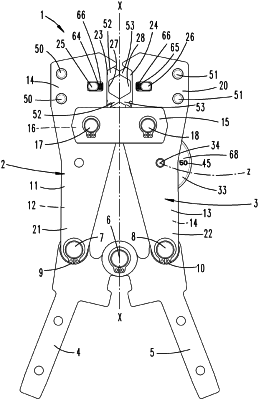| CPC H01R 43/042 (2013.01) [B25B 7/04 (2013.01); B25B 7/12 (2013.01); B25B 7/16 (2013.01); B25B 7/22 (2013.01); B25B 27/146 (2013.01); F16H 1/22 (2013.01); F16H 55/14 (2013.01)] | 20 Claims |

|
1. Crimping pliers configured to crimp cable lugs onto electrical conductors, comprising:
a first crimping jaw;
a second crimping jaw, the first and second crimping jaws being pivotally connected together at a pivot such that the first and second crimping jaws can be pivoted towards one another;
a first crimping matrix mounted for rotation on the first crimping jaw around a first axis of rotation, the first crimping jaw having a circumference and plurality of different first crimping dies formed in the circumference thereof;
a first interlock provided on the first crimping jaw and including a first spring;
a second crimping matrix mounted for rotation on the second crimping jaw around a second axis of rotation, the second crimping jaw having a circumference and plurality of different second crimping dies formed in the circumference thereof; and
a second interlock provided on the second crimping jaw and including a second spring, and
wherein the first and second interlocks are configured to lock the crimping matrices into working positions, the first and second crimping matrices being configured to be displaced in a movement transverse to the axes of rotation when rotated thereby unlocking the first and second crimping matrices from the working positions, and wherein the first crimping matrix can be moved from the working position only against action of a spring force of the first spring, the spring force of the first spring acting transversely to the first axis of rotation, and the second crimping matrix can be moved from the working position only against action of a spring force of the second spring, the spring force of the second spring acting transversely to the second axis of rotation.
|